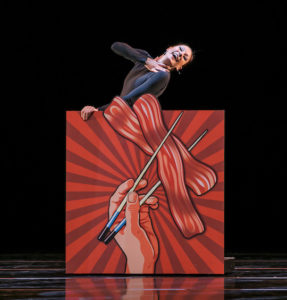“How can I describe you?” So starts the music by Nico Muhly and singer Teitur that is the inspiration for Val Caniparoli’s wry and sassy ballet, If I Were A Sushi Roll, which Smuin premiered in San Francisco on April 20. The ballet continued its run as the centerpiece of company’s Dance Series 2 this past week at the Lesher Center for the Arts in Walnut Creek, before moving on to Mountain View and Carmel.
The singer goes on as the Smuin ensemble, costumed as Men and Women in Black, shimmy and shiver brilliantly across the blue light–saturated stage: “I couldn’t say she looks just like Jane Fonda. You don’t look like Jane Fonda at all.” The song lyrics were derived from comments found on YouTube home videos, as the musical team pondered the meaning of personal videos made public. And the nine songs that the choreographer chose for the ballet are found in their 2016 album, Confessions.

Caniparoli picks up the idea of scrutinizing the personal and does so with equally whimsical good humor and a large-hearted admiration for the eccentric.
Hanging at the back of the stage just below the flies was a poster-like illustration of a closed circuit camera, its red recording light blinking above the dancers. Douglas Schmidt’s excellent illustration-like sets were wheeled in and out as small panels or appeared suspended on the upstage scrim. In “Describe you” a near life-size photo of Jane Fonda in workout gear on her back with her legs and torso lifted into a U-shape was pushed on stage across from a near human-size photo of a prawn, its body curved similarly, tail waving in the air. In “Printer in the Morning” Erica Chipp-Adams hung over a short panel painted with a hand wielding a pair of chopsticks dangling two strips of crispy bacon.
The choreography for each of the ballet’s songs, whether danced by one person or 14, used a short series of gestures as a kind of kinetic leitmotif. There were hands placed together and waving along like the motion of swimming fish in a hula; the guys gripped their muscles in body builder grimaces while the women stuck out a hip and bent their arms behind their head in a complementary starlet pose. These motifs were then bound together with synchronous and athletic moves from a variety of physical disciplines and blended into a final seamless combination of dance.
If I Were A Sushi Roll is a blast! And it fits this company’s skills like a glove, pulling the absolute best out of the dancers.
The program opened with Amy Seiwert’s Falling Up, which premiered in 2007, when Seiwert was the company’s choreographer-in-residence under Michael Smuin’s mentorship. Set to Brahm’s Intermezzi for Piano, it’s a very romantic piece both in its lyricism and its partnering, with four couples repeating patterns, dancing first in staggered lines, then in combinations. Seiwert comments that her impulse on seeing the work recently was to change it, but she also points out that it sits well as a moment in her history as a choreographer. And clearly, the work has an integrity that is lovely as it is.
The third ballet presented on the program was Helen Pickett’s Oasis, set to music by Jeff Beal written specifically for the ballet. The piece, like Seiwert’s, is contemporary ballet, intent on creating mood rather than telling a story. With curtain-like pale strings hanging in curves, through which the dancers moved, the sets acted as a screen where close-up video images of water bubbled. The dancers moved as if they were caught in waves, rather than swimming through them, giving the dance an elemental quality.
Although the three pieces referred to different threads of founder Michael Smuin’s work as a choreographer – his romanticism, his accessibility, his playfulness – it’s clear the company has moved on to create a different and more contemporary aesthetic for itself. And that’s all to the good.
— Jaime Robles
